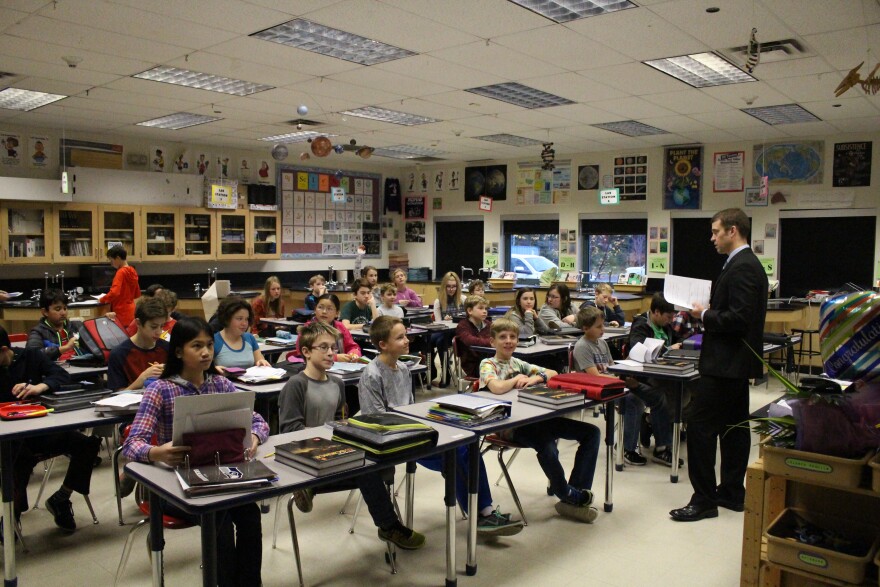The Anchorage School Board will decide Monday on several proposals to help close a major budget deficit for next school year.
Among the suggestions the board has expressed support for is increasing the pupil-to-teacher ratio by one. But teachers say they have a lot of concerns about adding even more students to already packed classrooms, including negative impacts to student learning and student safety.
Take English teacher Derek Reed at Bettye Davis East Anchorage High School. He said he's had as many as 36 students in one class already, and he can't imagine adding more.
“I didn’t even have enough desks or chairs for students," he said. "Everyone was crammed in so tight, they couldn’t even move around the room.”
In Anchorage schools, the average pupil-to-teacher ratio, or PTR, is about 27 to 1 right now. But that’s just an average and some teachers, like Reed, say their class sizes are much bigger.
Corey Aist, president of the Anchorage Education Association teachers union, said he worries about student learning.
“All the research indicates that it’s two factors that mostly affect student outcomes," Aist said. "Class size and family involvement.”
But the district and school board are in a tough spot. They need to cut spending next school year by $48 million, a deficit they say is largely due to state funding not keeping pace with inflation. The board is weighing a number of proposals, including increasing class sizes, cutting programs and shutting down schools.
Increasing the pupil-to-teacher ratio would close a fraction of the budget gap. District chief financial officer Jim Anderson said the PTR increase would result in a loss of about 60 teachers, saving the district a little over $7 million.
“So that would equal, on average, a little bit less than one teacher per school," he said. "But obviously, schools that lose more students or schools who gain more students would be impacted differently when we do a PTR change.”
Anderson has been in charge of the district’s finances since 2016, and he said there have been pupil-to-teacher ratio increases during that time, but only for classes above third grade. Middle and high school classrooms have felt the impacts the most.
At Romig Middle School, science teacher Ben Walker said with larger classes, it can be difficult to supervise all students and make sure everyone is on task. He said he’s regularly had more than 30 students per class in recent years.
“In terms of walking around the room and keeping an eye on what’s going on, you get into a side conversation with a kid and on the other side of the room, there’s really no one to supervise that," Walker said. "So the more we can limit those sorts of situations, the better. And it’s a lot easier with fewer kids.”
Also, as a science teacher, Walker said more students in a class present more safety concerns when they’re working with chemicals and Bunsen burners. He said he had so many students this year, he decided to teach an extra class period.
“I actually now gave up planning time and am teaching six classes instead of five in order to get those class sizes down," Walker said. "And I’m being compensated for it, but still it’s been a rough year not having a personal planning time.”

Up in Chugiak, at Mirror Lake Middle School, science and health teacher Kerri Lathrop said another issue is space.
“With 36 students, the only way I can arrange my room is with six rows of six," Lathrop said. "And kids in the back really can’t see what we’re doing in the front of the room. So it makes it really difficult for all the kids to have access to the materials that are being taught.”
Lathrop said she’s come home with bruises from bumping into cramped classroom desks, and worries what adding additional students would do.
Anderson, the district’s CFO, said he understands that there are no budget changes that would leave everyone involved happy. However, he said, increasing or decreasing the pupil-to-teacher ratio is one of the few moves that is reversible in the short term, should the Legislature decide to increase state funding.
He said the district reversed its increase about five years ago.
“And we had to issue layoff notices to a number of teachers," Anderson said. "About four weeks later, the state gave us one-time funding. We met with the board and we were able to take that one-time funding, and reoffer those positions back.”
School district officials, teachers and union officials all agreed that a long-term fix to budget instability is inflation-adjusted increases to state funding. The current budget proposal from Gov. Mike Dunleavy offers a slight bump to the base student allocation, though it’s far below the rate of inflation.
Meanwhile, Reed, the English teacher at East High, said years of budget uncertainty and cuts are leading to more and more teachers leaving the profession.
“I think even long-term teachers that have been there 30 years are going, ‘I think it’s about time for me,’" Reed said. "And new teachers are jumping ship earlier than what they imagined, and mid-career teachers that have 12, 15 years in are doing the same thing.”
The Anchorage School Board is expected to vote on several preliminary budget changes, including potentially increasing the pupil-to-teacher ratio, at their next meeting, Monday evening.


